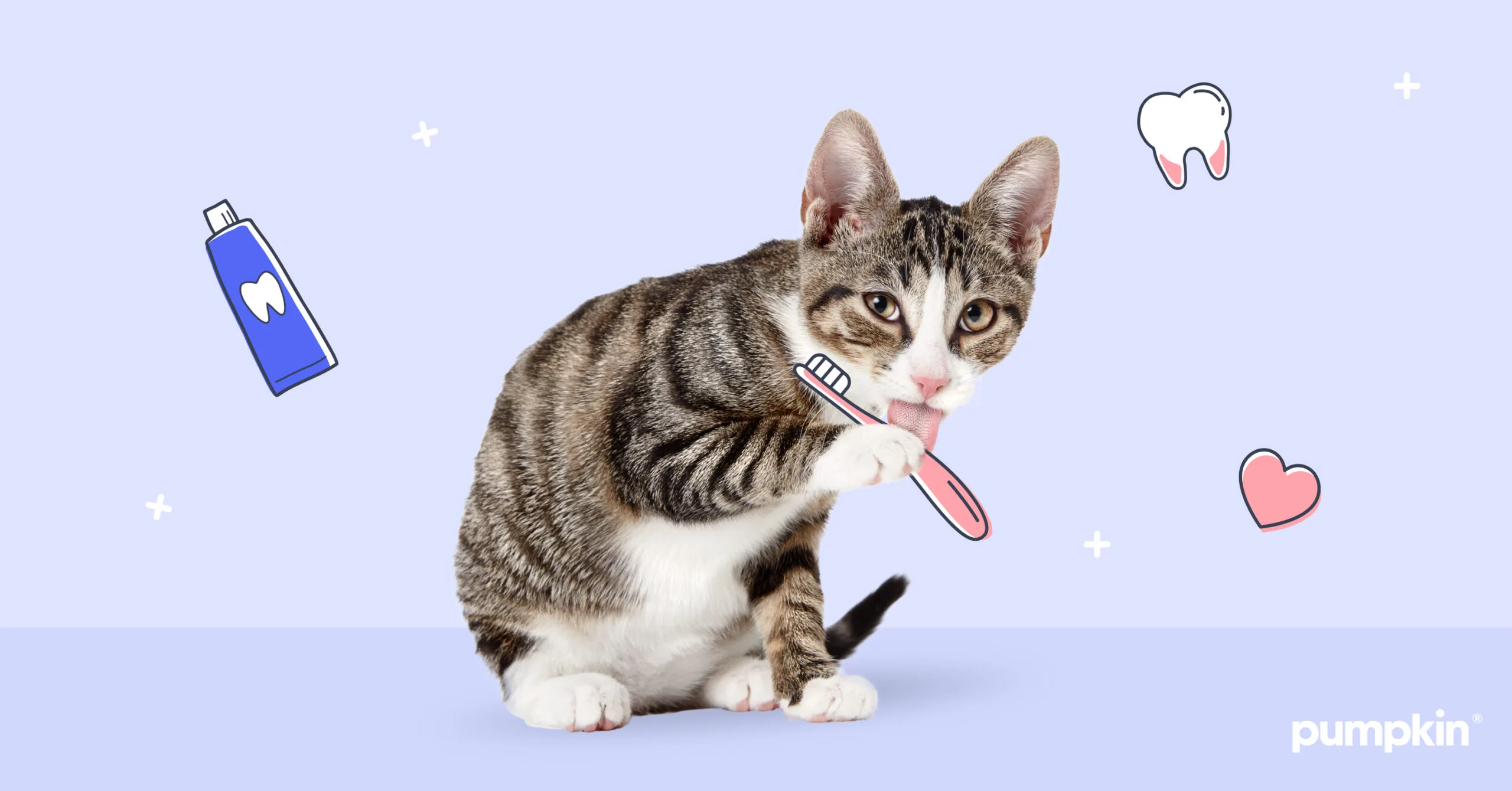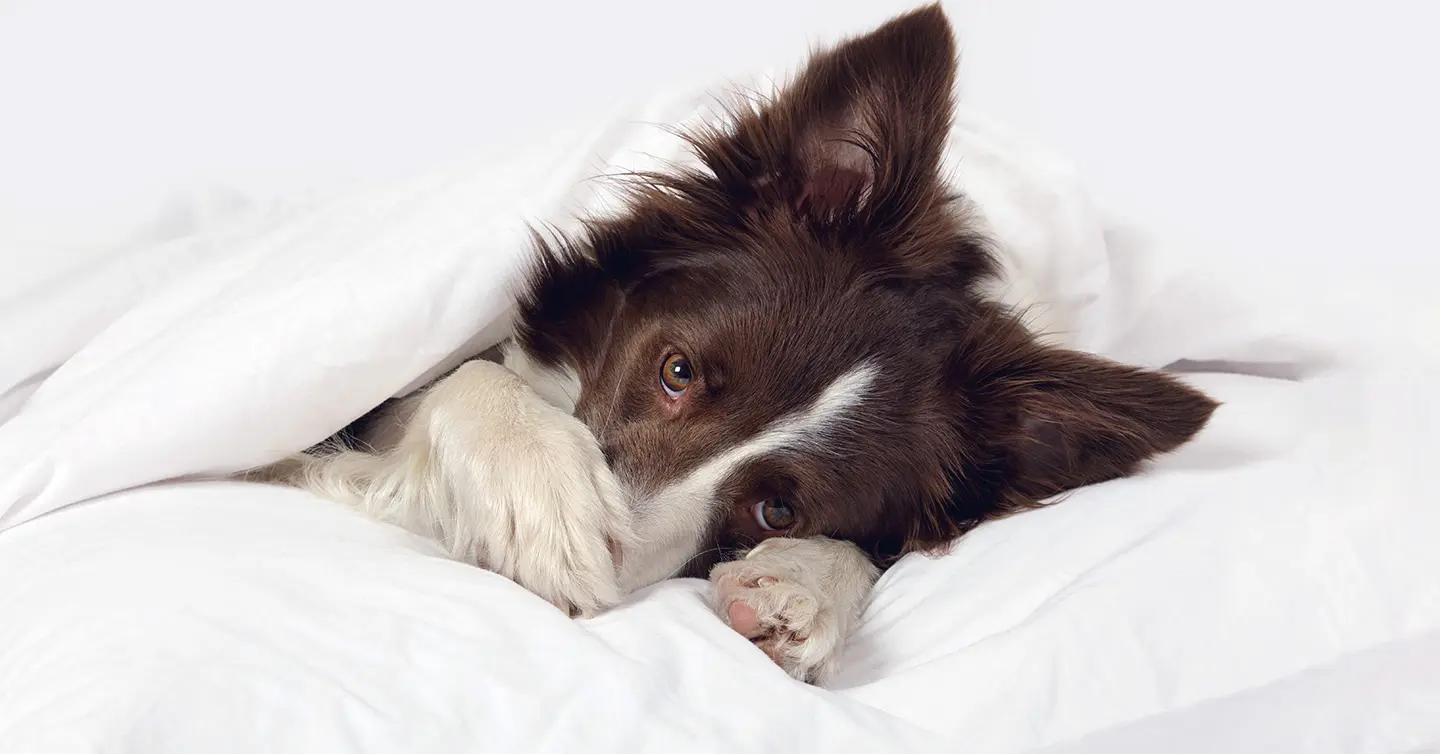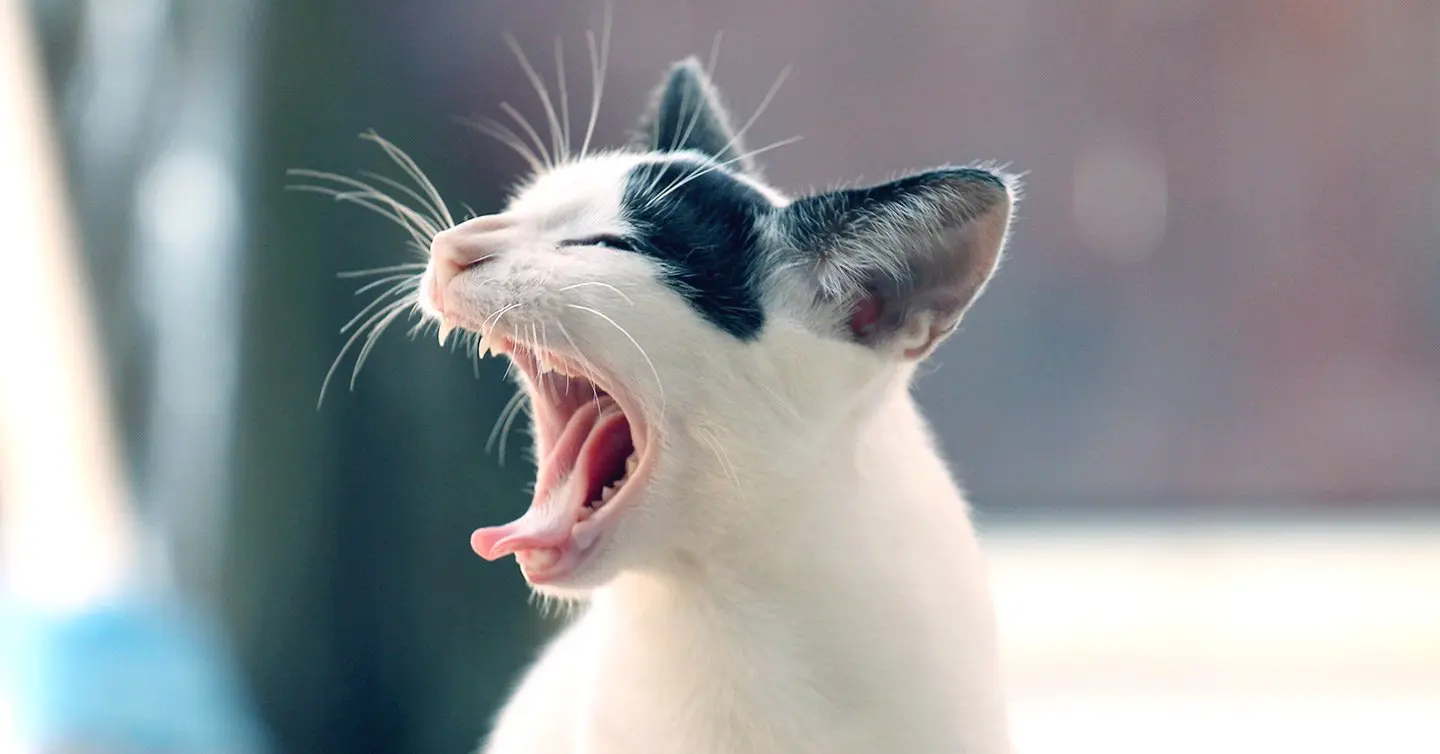Why Is Cat Dental Care Important?
Did you know that taking care of your kitty’s pearly whites is just as important as taking care of your own? With dental disease affecting 50% to 90% of cats over the age of four, regular dental care is essential to help keep your cat’s teeth and gums healthy throughout their life.
Cats need a little help from their humans when it comes to dental hygiene. In the wild, cats’ teeth are maintained by their diet. They eat small rodents and typically consume both the fur and bones – this flosses their teeth and scrapes the tooth surface clean.
Your indoor cat likely isn’t catching and eating small rodents on the regular! Without your assistance, your domestic kitty might not be meeting all their dental care needs and may develop dental disease later down the line.
How Does Cat Dental Disease Develop?
Cats’ unique tooth shape allows food to get caught between their teeth and along their gums. The combination of saliva, cat food, and bacteria creates plaque, a yellow, sticky substance that adheres to the tooth surface and calcifies into tartar. If your cat’s teeth aren’t cleaned and maintained properly, plaque and tartar can build up, which can cause:
- Tooth decay
- Bleeding, inflamed gums (gingivitis)
- Periodontal (gum) disease
- Painful infections and/or abscesses
- Bad breath
- Tooth loss
- Tooth decay
Periodontal disease – a big no-no!
Periodontal disease, or gum disease, is an infection of the tissue around a cat’s teeth and can cause bone and tooth loss in the advanced stages. In fact, it’s one of the most common diseases affecting both our canine and feline friends!
Here you can see what a healthy cat’s mouth looks like vs a cat’s mouth with periodontal disease.

Advanced periodontal disease often affects your cat’s health beyond their mouth. The harmful bacteria produced in your cat’s mouth enter the bloodstream and can gradually damage the heart, kidneys, and liver. This is why regular dental care is crucial for your cat’s overall health as well.
If left untreated, advanced periodontal disease can also trigger Feline Tooth Resorption. This is when the dentin in the tooth (the bit right underneath the enamel) erodes. This affects close to 75% of cats over the age of five and is the most common reason for tooth loss in cats.
“Good pet dental health is the foundation for good overall health. Chronic bacteria in periodontal disease will not only cause discomfort in the mouth but also have the potential to spread to vital organs like the kidneys, liver, and heart.“
Dr. Patricia Collins, DVM
The good news is that a consistent dental routine can decrease your cat’s chances of developing dental issues later down the line. And if you know what signs to look for, you can catch dental problems early enough to treat them.
As with any serious health condition, the costs of treating dental disease can add up quicker than you might think. If your cat does develop dental disease, it’s priceless to know you have help getting them the treatment they need. With a pet insurance plan that covers dental illnesses – like a Pumpkin Pet Insurance plan – you can have peace of mind knowing you have help affording your kitty’s eligible veterinary bills.
Top 3 Ways to Help Prevent Dental Disease

Consistent dental care is the best way to prevent feline dental disease and keep your kitty’s mouth healthy. Here are three important ways you can help prevent dental health problems:
1. Regular Professional Dental Checkups and Cleanings
Getting regular dental checkups is crucial for preventing dental health issues and catching the early signs of dental disease. Depending on your cat’s age, genetics, diet, and overall health, your veterinarian may advise yearly, or twice-yearly dental exams to keep your cat’s oral health and overall well-being in tip-top condition.
For the checkup, the veterinarian will conduct a full oral health exam, including measuring periodontal pockets around the teeth with a blunt probe and taking X-rays. They will look for:
- Any missing or extra teeth, an overbite, or an under-bite
- Fractured or broken teeth
- Presence of gingivitis or periodontal disease
- Buildup of tartar on teeth and along the gumline
- Abscesses or signs of infection
- Bumps or lesions that may indicate a tumor
- Any facial swelling
During the cleaning, your veterinarian will:
- Polish your cat’s teeth to smooth out the surface and make it harder for plaque to stick
- Flush your cat’s mouth to remove any remaining bits of plaque or tartar
- Make any recommendations for ongoing dental care
For a professional dental cleaning and checkup, the veterinarian will put your cat under anesthesia to keep them still and safe. This allows your cat to rest pain-free while the veterinarian does all the necessary checks and cleaning. To make sure general anesthesia is safe for your cat, your veterinarian will conduct a thorough pre-anesthesia evaluation and monitor your cat’s vital signs throughout the procedure.
This step is important because often your veterinarian can’t know the extent of dental disease until your cat is under anesthesia and they perform a complete dental exam, including x-rays.
“There can be many reasons a pet parent is reluctant to get a cleaning, like previous anesthesia experience, discomfort, scared of being separated from their pet for the day etc. but the two most common reasons I find that people are reluctant to do regular cleanings are: 1. they think that dental disease is normal (so they don’t think it’s necessary to have them cleaned) and 2. anesthesia concerns. The anesthesia concern is usually addressed by helping pet parents understand that blood work is required before the procedure to make sure overall health is good and we have all the monitoring equipment to make sure ALL our vitals and things like EKG, Blood Pressure…all monitored throughout the procedure.“
Dr. Mondrian Contreras, DVM
Now’s a great time to schedule your annual dental cleaning with your veterinarian!

2. At-Home Tooth Brushing
Regular brushing and at-home care are the most important things you can do to prevent dental disease. Even though dental disease is common and affects a majority of cats, a massive 73% of cat parents don’t brush their kitty’s teeth at all!
Brushing those feline teeth weekly, or daily if you can, is a great way to help prevent the buildup of plaque, which is a yellow-colored bacteria film. Brushing regularly gently removes that leftover gunk that can calcify into tartar. This is key as once tartar forms, it can only be removed by a veterinarian.
Many cats aren’t crazy about you messing with their mouths, but it’s possible to ease them into the process with patience and treats. The earlier you can start a dental care routine with your kitty, the better for their health. Here’s some advice to help you get those teeth clean.
“Certainly cats can be tricky. Best to start a routine when they are very young. Slowly start touching their face and mouth. Best to use a finger brush or wipes. Don’t pry their mouth open, just clean the outside surfaces of their teeth. Most plaque settles on the buccal side (the cheek-side) of teeth anyway so usually that is all you need to do. Be careful to not get inadvertently bitten as cat bites can be trouble.“
Dr. Patricia Collins, DVM
How to clean your cat’s teeth at home
Step 1 – Start early and gradually
First, you want to get your cat used to you touching their teeth and gums. Gently rub around the mouth, and when your cat is comfortable with that, try slipping your finger in between their lips and touching their gums. When they’re ready, you can try rubbing your finger over their teeth as well.
Step 2 – Make teeth cleaning tasty
The next step is to add the toothpaste. Pet toothpaste comes flavored with chicken or fish, and your cat should find it yummy. Let your cat smell and lick it first, and if they like it, you can try rubbing it gently on the outside of the teeth. A dab on your finger is all you need. Never use human toothpaste as fluoride will upset your cat’s digestive system.
Step 3 – Introduce the toothbrush
A cat toothbrush does a great job of removing food buildup from your cat’s teeth, so it’s worth it to get your cat on board. Cats like to chew on bristles, so offer the brush to let your cat get used to the texture and brush in their mouth. If a toothbrush is a no-go, a finger brush, a dental wipe, or gauze wrapped around your finger is a great alternative.
To clean, you can put the toothbrush, finger brush, or gauze with toothpaste into your cat’s mouth, and gently rub against the outside of the teeth in small, slow circles. Be sure to gently massage the gums as well.
Step 4 – Keep it brief and fun
Try to make the brushing quick, a few minutes max, and keep the atmosphere calm and relaxing. Start with just a few teeth in the beginning if you need. Cat treats can help you along and make brushing a positive experience. Make sure to reward your kitty by giving them lots of love and attention afterward!
Ideally, your cat’s teeth should be brushed daily, although brushing at least three times per week will help with your cat’s oral care and prevent gum disease.
If you’d like to see this in practice, watch this helpful video.
“Nothing takes the place of brushing, I always make sure owners know that, then I direct them to the Veterinary Oral Health Council website for veterinary dentist-approved products for their pets, and make sure that they use approved products while also ALWAYS BRUSHING their pet’s teeth.“
Dr. Mondrian Contreras, DVM
3. A Balanced, Healthy Diet with Dental Treats
A balanced diet plays a key role in healthy teeth and gums and boosts your cat’s overall health. When cats have dental disease, veterinarians may prescribe dental food designed to reduce the growth of bacteria and plaque. The kibble in this type of diet is larger, and the fibers are formulated to encourage chewing or biting – this creates the abrasive action of cleaning the teeth.
You can supplement a healthy diet with dental products that contain enzymes and other ingredients that fight bacteria. These might include oral care products like rinses or sea kelp additives (water additives) in small amounts. These are helpful if your cat won’t let you come near them with a toothbrush!
Remember, you can safely give your cat any product approved by the Veterinary Oral Health Council.

How to Spot the Signs of Dental Disease
If your cat licks your face and you can smell radioactive kitty breath, it might mean they’re having dental problems! It’s important to be alert to changes in your cat’s behavior because cats won’t always show you that they’re in pain.
Tooth or mouth pain is especially hard to spot because a cat will continue eating normally until the dental problems are advanced and very painful. Knowing exactly what to look out for is key in recognizing and seeking treatment for cat dental disease, and we’re here to help.
These signs are clear indicators that something is up with your cat’s chompers:
- Unusually smelly breath
- Bloody or swollen mouth or gums
- Facial swelling
- Pain around or inside the mouth – you may notice this when your cat takes a bite of something (often cold) and makes a ‘funny face’
- Exposed tooth roots
- Visible tartar buildup and discolored teeth
- Pawing the teeth or mouth
- Drooling (sometimes bloody)
- Dropping food when eating
- Decreased appetite or difficulty eating (e.g. will only eat canned food)
- Grooming less often
- Weight loss
Kitty teeth are small and can be hard to check. Remember, even though you should always do your own checks, nothing can replace a dental exam by your veterinarian.
“In terms of the differences between pets who have had a good dental routine early in life compared to those who haven’t, the difference is typically dramatic because those pets do not have to deal with oral pain (gingivitis) and their breath smells great. Most pets with early intervention keep all their teeth throughout their life thus not having to endure periodontal disease – like tooth decay, inflamed gums, and tooth loss. All of which can affect our pet’s quality of life.“
Dr. Mondrian Contreras, DVM
How Dental Disease is Treated
If you notice something is wrong or your veterinarian’s exam reveals signs of dental disease, the treatment for your cat will depend on how advanced the disease is.

| Level | Description | Treatment |
| Mild | There’s a buildup of plaque and tartar on the tooth, red gums, but no bone loss. | A professional cleaning and ongoing daily brushing can treat this. |
| Moderate | There’s a buildup of plaque and tartar on the tooth, red gums, and some mild bone loss. | A professional cleaning and ongoing daily brushing will be necessary so there is no further bone loss. |
| Advanced | There’s a buildup of plaque and tartar on the tooth and below the gumline, inflamed gums, and significant bone loss. | A professional cleaning and ongoing daily brushing will be necessary so there is no further bone loss, and extraction will be required for teeth with too much bone loss. |
| Severe | Over 50% of the bone has been lost, the gums are infected, and in the most severe cases, the infection has spread to the bloodstream. | Damaged teeth will need to be extracted, and the gums will need to be surgically closed with sutures. If an infection is present, antibiotics are typically prescribed. Cats will also need soft food and pain management after dental treatments. |
If your cat needs oral surgery, a Veterinary Dental Specialist may be called in for more involved procedures such as removing tumors, excising gums with severe periodontal disease, or tooth extractions for damaged, impacted teeth, and tooth resorption. These procedures may sound scary, but your cat will quickly be back to their normal selves.
The Final Word on Your Cat’s Dental Health
Dental disease, no matter what degree, definitely isn’t the cat’s pajamas. It’s vitally important for cat owners like you to take care of your cat’s teeth by maintaining a consistent routine, having regular professional cleanings, and providing the right diet so the best cat in the world can live a longer, healthier life.
The next time you see your veterinarian, ask their advice for the best dental care for your cat and if they recommend any specific preventative measures. Your kitty (and all 30 of their teeth) will thank you for it!
If your cat develops dental disease, it pays to have pet insurance to help you cover the costs of the treatment they may need. Pumpkin Pet Insurance plans offer up to 90% cash back on veterinary bills for eligible dental illnesses, making it easier to say ‘yes’ to the best dental care for your cat.
Please note: The information presented in this article is for educational and informational purposes only and does not constitute or substitute for the advice of your veterinarian.




